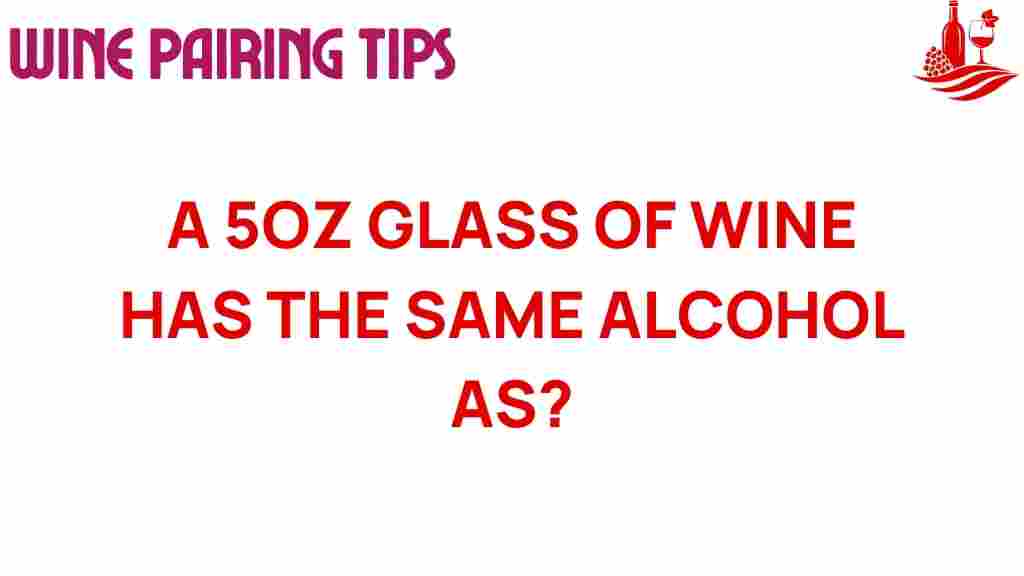The Surprising Truth: Wine Alcohol Content in Your 5oz Glass
When it comes to enjoying a glass of wine, many people are unaware of the actual wine alcohol content in their favorite beverage. Understanding how much alcohol is in your 5oz glass of wine can be enlightening and may even change the way you drink. This article dives deep into the wine serving size, the alcohol comparison with other beverages, and essential drinking facts that everyone should know. We’ll also provide some health tips and clever ways to measure your wine.
Understanding Wine Alcohol Content
Before we explore the specifics of a 5oz glass, it’s vital to understand what wine alcohol content actually means. The alcohol by volume (ABV) percentage indicates how much of the beverage is pure alcohol. Most wines typically range from 8% to 15% ABV, though some can be higher.
- Low-Alcohol Wines: 8% – 10% ABV (e.g., some Rieslings, Lambruscos)
- Moderate-Alcohol Wines: 10% – 13% ABV (e.g., Pinot Noir, Merlot)
- High-Alcohol Wines: 13% – 15% ABV (e.g., Zinfandel, Cabernet Sauvignon)
- Fortified Wines: 15% – 20% ABV (e.g., Port, Sherry)
How Much Alcohol is in a 5oz Glass of Wine?
Now, let’s break down the wine measurement for a standard serving. A standard 5oz pour of wine can contain varying amounts of alcohol based on the ABV percentage of the wine you are drinking. Here’s how the math works:
- If you have a wine with 12% ABV:
Alcohol content = 5oz x 0.12 = 0.6oz of pure alcohol. - If your wine has 14% ABV:
Alcohol content = 5oz x 0.14 = 0.7oz of pure alcohol. - If your wine has 15% ABV:
Alcohol content = 5oz x 0.15 = 0.75oz of pure alcohol.
This simple calculation shows that even a moderate glass of wine can contain a significant amount of alcohol, especially when compared to other beverages.
Alcohol Comparison: Wine vs. Other Beverages
To better understand the alcohol content of your wine, it’s helpful to compare it to other drinks. Here’s a quick comparison of some common beverages:
- 5oz Glass of Wine: 0.6 to 0.75oz of alcohol, depending on ABV.
- 12oz Beer (5% ABV): 0.6oz of alcohol.
- 1.5oz Shot of Liquor (40% ABV): 0.6oz of alcohol.
- 12oz Hard Seltzer (5% ABV): 0.6oz of alcohol.
While wine and beer might have similar alcohol content, it’s essential to consider serving sizes. A 5oz glass of wine is often more concentrated than a 12oz beer, which can lead to quicker intoxication if consumed at the same pace.
Understanding Wine Serving Size
The standard serving size for wine is typically 5oz, but many people may pour more, especially at home. Here are some tips on how to serve and measure wine properly:
- Use a Measuring Cup: If you want to be precise, use a measuring cup to pour your wine. This is especially useful when trying to control your alcohol intake.
- Wine Glass Markings: Many wine glasses have etched lines indicating serving sizes, making it easy to pour the right amount.
- Standard Wine Bottle: A standard wine bottle contains 750ml, which equals about five 5oz servings.
Drinking Facts You Should Know
Being informed about your drinking habits is crucial. Here are some essential drinking facts related to wine:
- Moderation is Key: The CDC defines moderate drinking as up to one drink per day for women and up to two drinks for men.
- Alcohol Absorption: Alcohol is absorbed into the bloodstream quickly, so consuming wine with food can help slow this process.
- Hydration Matters: Alcohol can dehydrate you, so it’s important to drink water alongside wine.
- Know Your Limits: Everyone’s tolerance to alcohol varies, so it’s essential to understand your limits.
Health Tips for Wine Drinkers
While wine can be enjoyed responsibly, it’s essential to consider health implications. Here are some health tips for wine drinkers:
- Choose Quality over Quantity: Opt for higher-quality wines and savor the experience, rather than consuming larger quantities.
- Consider Your Health: If you have health conditions or are on medication, consult your doctor about alcohol consumption.
- Mindful Drinking: Pay attention to how alcohol affects your body and adjust your consumption accordingly.
- Explore Low-Alcohol Options: Many wines with lower ABV are available, allowing you to enjoy wine with less alcohol content.
Common Troubleshooting Tips
Sometimes, people may have questions or issues regarding their wine consumption. Here are some common troubleshooting tips:
- Feeling Overwhelmed by Alcohol: If you find that one glass of wine makes you feel too intoxicated, consider switching to lower ABV options or reducing your serving size.
- Wine & Food Pairing Confusion: If you’re unsure what wine to pair with your meal, seek guidance from wine pairing resources or ask your local sommelier for recommendations.
- Storage Questions: If you’re unsure how to store leftover wine, use a vacuum pump to remove air from the bottle and refrigerate it to preserve quality.
Conclusion: Elevate Your Beverage Knowledge
Understanding the wine alcohol content in your 5oz glass can significantly enhance your drinking experience. By knowing how to measure your wine accurately, comparing it to other beverages, and being aware of drinking facts, you empower yourself to make informed choices. Remember to savor your wine in moderation and apply the health tips provided to enjoy your beverage responsibly.
For more information on wine selection and serving, check out this informative resource.
Finally, always keep learning and expanding your beverage knowledge. With the right information, you can enjoy wine in a way that enhances both your culinary experiences and your health.
This article is in the category Tips and created by Wine Pairing Tips Team
